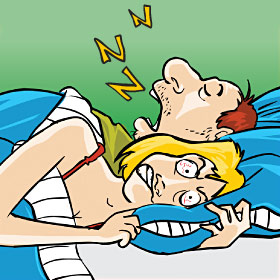Snoring & Sleep Apnea
How dentistry can improve your sleep and health
Dear Doctor,
My husband's snoring has gotten worse to the point where he almost stops breathing. His dentist recently told him this could be dangerous and should be treated. What can be done, and why is it a dental concern?

Dear Sandra,
Your question is timely as more research and knowledge is accumulating in the area of sleep and sleep disorders. Here is a brief introduction in response to your question.
Snoring occurs when the soft tissue structures of the upper airway (back of the throat) collapse onto themselves, the tongue drops back, and air is obstructed in its movement through the mouth and nose into the lungs. As a result, these obstacles create the vibration that produces snoring. Large tonsils, a long soft palate, a large tongue, the uvula (the tissue that looks like a mini punch-bag dangling at the back of the mouth), and even fat deposits can also contribute to blockage and hence snoring.
Your husband may have a condition called Obstructive Sleep Apnea (OSA; “a“ – without; “pnea” – breath), which occurs when the upper airway collapse becomes more profound causing significant airflow disruption, or even no airflow whatsoever for 10 or more seconds. This is often associated with many “micro-arousals,” one to three second waking episodes throughout the sleep cycle. This can be quite dangerous to health as blockage of the upper airway causes reduced airflow into the lungs and therefore low blood oxygen levels. And when oxygen levels drop low enough, the brain moves out of deep sleep and the individual partially awakens followed by a loud gasp as the flow of air starts again. This can happen many times during the night, sometimes more than 50 times an hour. The combination of low oxygen levels and fragmented sleep are the major contributors to most of the ill effects associated with sleep apnea. In addition to excessive daytime sleepiness, studies show that sleep apnea patients are much more likely to suffer from heart attack, congestive heart failure, high blood pressure, brain damage and strokes, as well as a higher incidence of work and driving-related accidents.
Oral appliances are worn in the mouth to treat snoring and Obstructive Sleep Apnea (OSA). These devices may look like orthodontic retainers or sports mouth guards but are designed to maintain an opened, unobstructed, upper airway during sleep.
Some helpful things you can do for yourself if you have sleep apnea include losing weight and exercising. Medical and dental treatments include:
Continuous Positive Airway Pressure (CPAP): CPAP bedside machines generate pressurized air delivered through a tube connected to a mask covering the nose and sometimes mouth. The force of the pressurized air opens the airway (windpipe) in the same manner as blowing into a balloon; when air is blown in, the balloon opens and gets wider.
Oral Appliance Therapy: Here's the dental connection. Oral appliances are worn in the mouth to treat snoring and OSA. These devices may look like orthodontic retainers or sports mouth guards but are designed to maintain an opened, unobstructed, upper airway during sleep. There are many different oral appliances available but less than 20 have been approved through the FDA (Food and Drug Administration) for treating sleep apnea. They may be used alone or in combination with other means to treat OSA. And they work in several ways: repositioning the lower jaw, tongue, soft palate and uvula; stabilizing the lower jaw and tongue; and increasing the muscle tone of the tongue.
Other Dental Approaches: Specially trained oral and maxillofacial surgeons may include more complex jaw advancement surgeries. Additionally, an Ear, Nose & Throat (ENT) specialist may consider surgery to remove excess tissues in the throat. It also may be necessary to remove the tonsils and adenoids (especially in children), the uvula, or even parts of the soft palate.
Since OSA is a serious medical condition, a physician specially trained in this area of medicine must diagnose it. Diagnosis is based on the results of an overnight laboratory sleep study called a polysomnogram (PSG; “poly” – many; “somno” – sleep; “gram” – record). However, determining the best treatment is enhanced by joint consultation with your physician and dentist. It is also important to note that only dentists trained in sleep disorders and related oral appliance therapy are familiar with the various designs of appliances. These experts can best determine what is suited for an individual's specific needs as well as manage any unruly tooth, bite, gum, or jaw joint effects.
If your husband needs an oral appliance, it may take several weeks to months to complete. Afterwards, your husband's dentist will continue to monitor his treatment and evaluate the response of his teeth and jaws. His dentist needs to work with a physician as part of the medical team in diagnosis, treatment, and on-going care of your husband's sleep disorder.
In conclusion, chronic loud snoring, pauses in breathing during sleep, and daytime sleepiness are neither benign nor inconsequential and should be addressed early to avoid serious health problems. These can include heart problems, blood pressure issues, and brain and general health effects on the body — all of which can affect long-term health and well-being.




